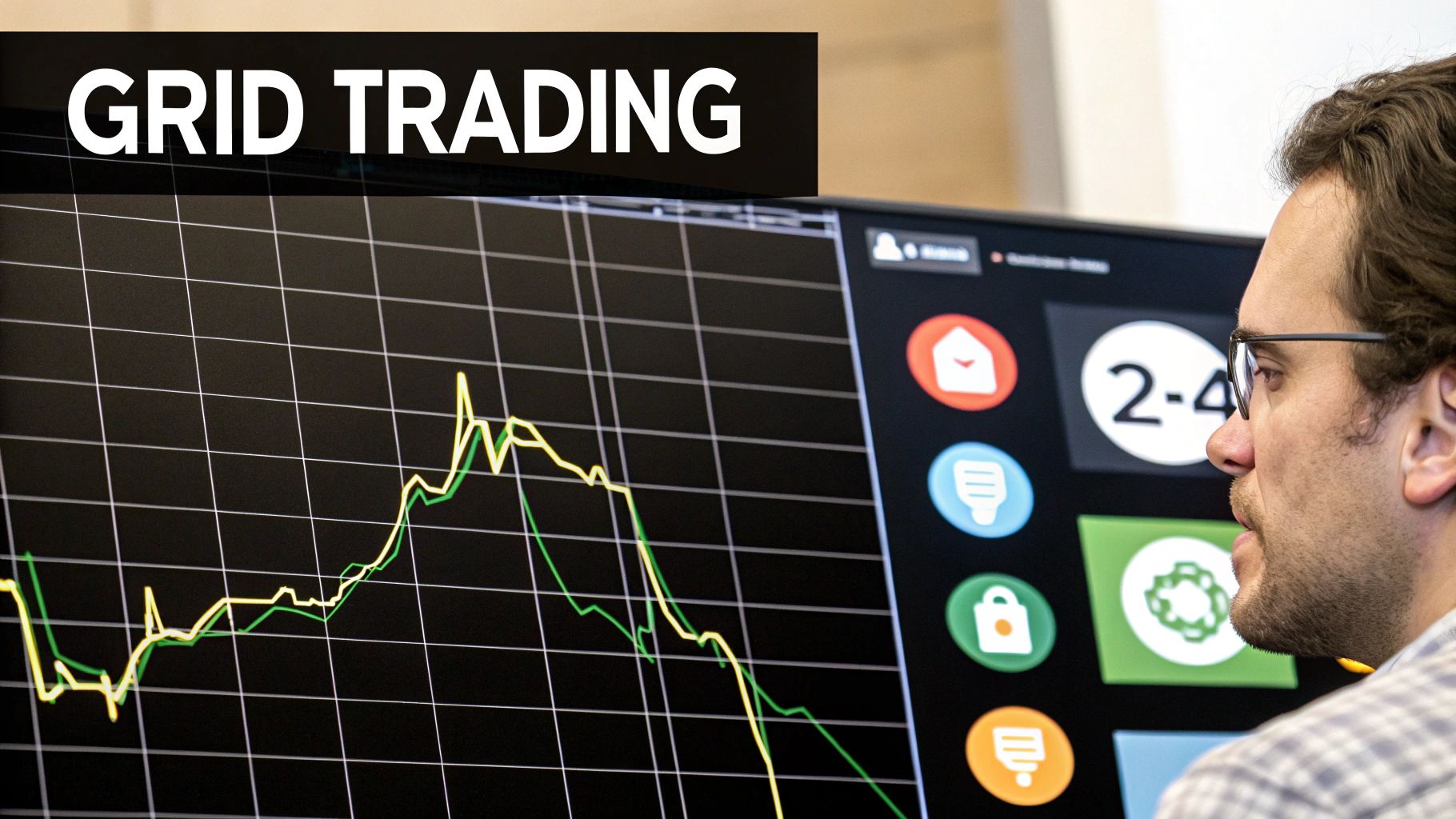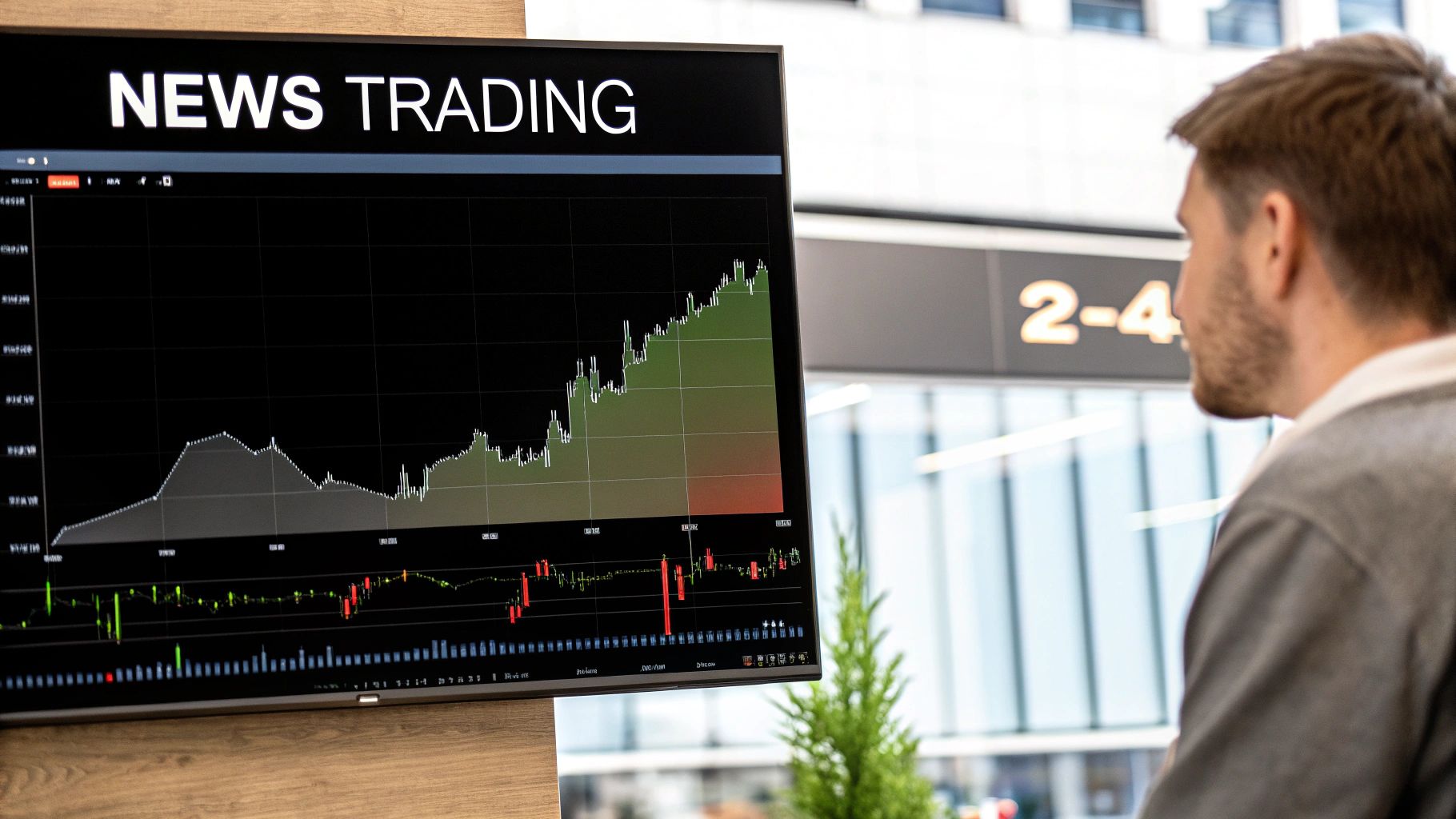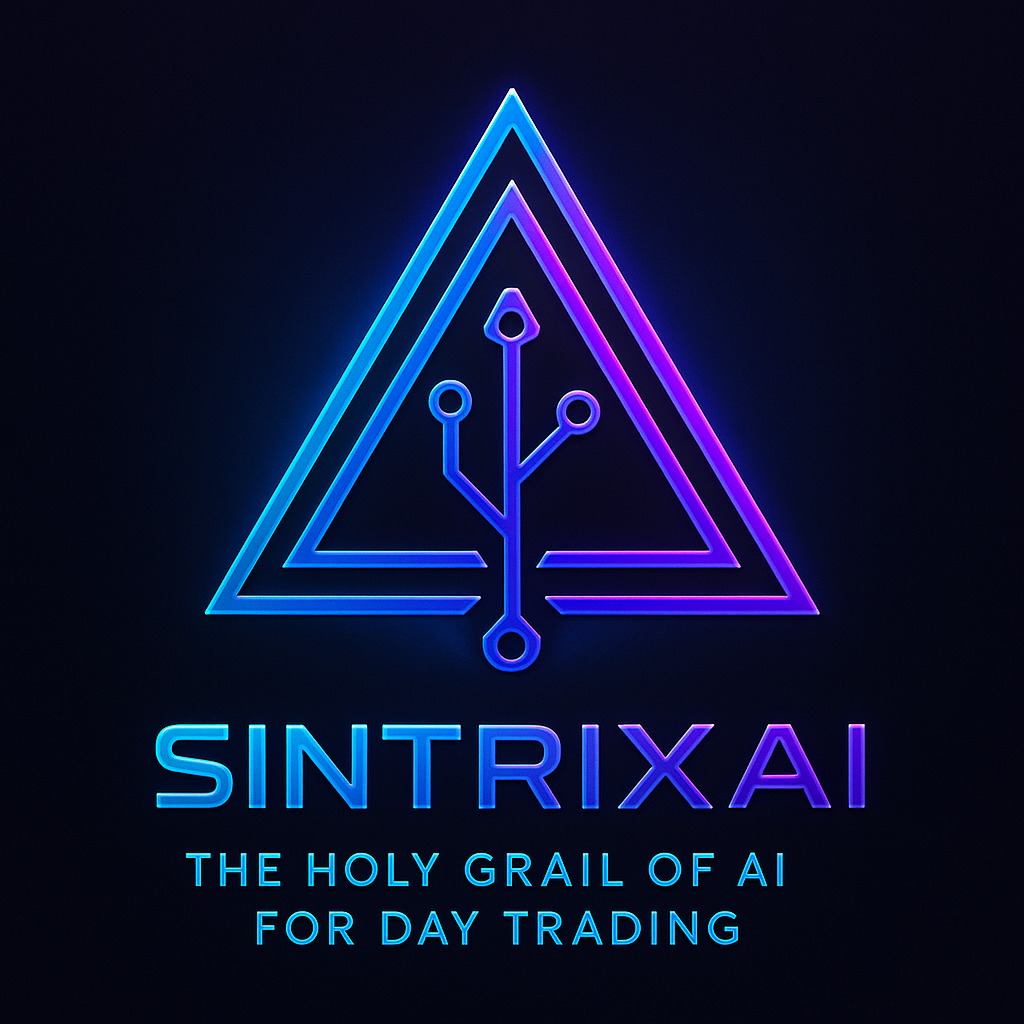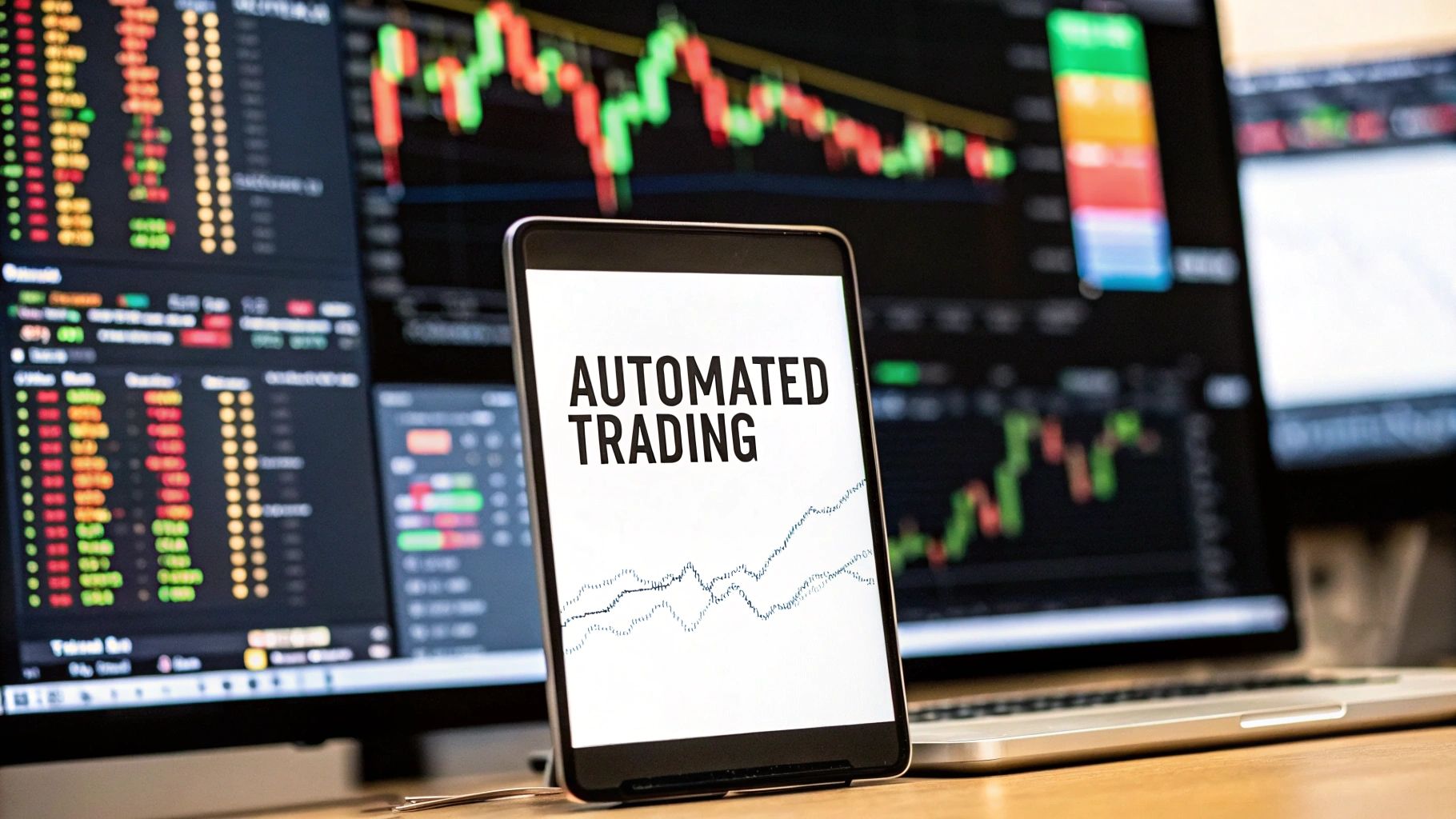Welcome to an in-depth exploration of the best automated trading strategies that are reshaping how traders approach the markets. Since our launch in 2014, Trading Made Easy has been dedicated to a single, powerful mission: to demystify the complexities of day trading and empower individuals with tools that deliver speed, precision, and consistency. In an industry where emotions can derail the most well-laid plans, our automated day trading software provides a disciplined, data-driven alternative, helping you work from home with a clear day trader mindset.
This guide moves beyond generic advice to provide a clear roadmap. We will dissect nine distinct strategies, from momentum and mean reversion to arbitrage and news-based trading. For each one, you will learn:
- How It Works: The core logic behind the strategy.
- Pros and Cons: A balanced view of its strengths and weaknesses.
- Ideal Use Cases: Who it's best suited for, whether you're a beginner or an experienced trader.
- Implementation Tips: Actionable steps for putting the strategy into practice.
Understanding these concepts is the first step toward harnessing the full potential of algorithmic trading and achieving your financial goals. Let's dive in and simplify your trading journey.
1. Momentum Trading Strategy
A momentum trading strategy is one of the best automated trading strategies for capitalizing on established market trends. The core principle is straightforward: assets that are performing well will likely continue to do so, while underperforming assets will continue to fall. Automated systems excel at this by systematically scanning markets for assets exhibiting strong upward or downward price movements, executing trades to ride the trend until signs of reversal appear.
Pioneered by legendary investors like Richard Driehaus, this approach isn't about buying low and selling high. Instead, it’s about buying high and selling higher. An algorithm can be programmed to identify stocks breaking out to new 52-week highs on significant volume, automatically entering a long position. The system then holds the position as long as key momentum indicators, like the Relative Strength Index (RSI), remain above a certain threshold (e.g., 70), signaling sustained buying pressure.
Key Aspects for Automation
For traders looking to implement this, a key focus is on defining clear, quantifiable rules for entry and exit.
- Entry Signal: A common rule is to enter a trade when a stock's price crosses above its 50-day moving average while its RSI is also above 60.
- Exit Signal: A strict stop-loss order is crucial. An automated system can place a trailing stop-loss that moves up with the price, locking in profits while giving the trend room to run. For example, setting a 10% trailing stop will automatically sell the position if the price drops 10% from its peak.
The infographic below summarizes the core components for building a robust automated momentum strategy.
As highlighted, combining powerful indicators like RSI and MACD with strict risk controls in trending markets creates a powerful foundation for this strategy. Our automated day trading software at Trading Made Easy is designed to simplify this process, allowing even beginner day traders to deploy sophisticated strategies without needing to code them from scratch.
2. Mean Reversion Strategy
A mean reversion strategy is another one of the best automated trading strategies, operating on the principle that asset prices eventually return to their historical average or mean. Unlike momentum trading that follows trends, this approach bets against them. An automated system identifies assets whose prices have moved to an extreme high or low and executes a trade in the opposite direction, anticipating a correction back toward the average.
This concept, rooted in the work of luminaries like Louis Bachelier and Eugene Fama, posits that extreme price movements are often temporary overreactions. Quantitative hedge funds like D. E. Shaw and Renaissance Technologies have famously built sophisticated models around this idea. An algorithm can be designed to calculate a moving average for a stock and trigger a buy order when the price drops significantly below it, or a sell order when it rallies far above it, profiting from the eventual "snap-back."
Key Aspects for Automation
For traders implementing mean reversion, the focus is on statistically defining "extreme" and setting precise entry and exit points.
- Entry Signal: A common rule is to enter a short position when an asset’s price moves more than two standard deviations above its 20-period moving average. Conversely, a long position could be triggered when the price falls two standard deviations below the mean.
- Exit Signal: The exit is just as critical. The system can be programmed to close the position automatically once the price returns to its moving average. A protective stop-loss should also be set just beyond the entry point to manage risk if the price continues its extreme move instead of reverting.
By quantifying overbought and oversold levels, automation allows traders to systematically exploit short-term pricing inefficiencies. Our software at Trading Made Easy simplifies deploying such strategies, giving traders powerful tools to capitalize on market volatility without needing to master complex statistical analysis or constant manual chart monitoring.
Key Features of Trading Made Easy’s Software
At Trading Made Easy, we've engineered our automated day trading software with unique features designed to give traders a distinct advantage. Our platform is built on transparency and precision, ensuring you can execute the best automated trading strategies with confidence.
- Proven Proprietary Algorithms: Our software comes pre-loaded with time-tested algorithms that have consistently performed in live market conditions. This eliminates the guesswork and steep learning curve associated with building strategies from scratch.
- Transparent "Glass Box" System: Unlike "black box" solutions where the logic is hidden, our system is fully transparent. You can see the rules and understand exactly why each trade is placed, empowering you to learn and trust the process.
- Multi-Platform Compatibility: Our software integrates seamlessly with popular trading platforms like NinjaTrader, E*TRADE, and others, giving you the flexibility to trade in your preferred environment.
- Dedicated Support and Education: We provide comprehensive training and ongoing support to ensure you get the most out of our software. Join our free weekly webinars to see live demonstrations and learn directly from experts.
These features are designed not just to automate trades, but to enhance your trading intelligence and discipline.
4. Grid Trading Strategy
A grid trading strategy is one of the best automated trading strategies for systematically profiting from market volatility, especially within a defined range. The core concept involves placing a series of buy and sell orders at predetermined intervals above and below a central price point. This creates a "grid" of orders, allowing an automated system to consistently buy low and sell high as the price fluctuates within this grid. Automation is essential, as it executes these numerous small trades without emotion or delay.
This strategy thrives in sideways or ranging markets, common in forex pairs like EUR/USD or cryptocurrencies like Bitcoin during consolidation phases. An algorithm establishes the grid, automatically executing a buy order when the price hits a lower grid line and a sell order when it hits a higher one. The profit is generated from the cumulative gains of these frequent, small trades. For example, a crypto grid bot on Binance might be set on the BTC/USDT pair between $60,000 and $65,000, placing orders every $100 to capture minor price oscillations.

Key Aspects for Automation
For traders implementing grid trading, success hinges on defining the grid parameters correctly based on market conditions.
- Grid Setup: Define a price range (upper and lower bounds) and the number of grid levels. For instance, in a moderately volatile market, a trader might set a grid on a stock with 10 levels, spaced 1% apart.
- Risk Management: A crucial rule is setting a stop-loss outside the grid's range. If the price breaks out of the established range decisively, the automated system will close all positions to prevent significant losses. Careful monitoring of margin requirements is also vital.
The video below offers a deeper look into the mechanics and application of grid trading.
As you can see, this strategy turns market noise into a predictable source of profit, but it requires precise execution. For those interested in building an automated trading system, our platform provides the tools to deploy it effectively without manual oversight.
5. Statistical Arbitrage (Pairs Trading)
Statistical Arbitrage, often executed through pairs trading, is one of the most sophisticated market-neutral automated trading strategies available. Its foundation lies in identifying two securities whose prices have historically moved in tandem. The strategy profits from temporary deviations in this relationship, buying the underperforming asset while simultaneously shorting the outperforming one, betting on their eventual return to their historical mean.
Pioneered by quantitative minds like Gerry Bamberger and Nunzio Tartaglia at Morgan Stanley, this strategy is designed to be insulated from broad market movements. For example, an algorithm might identify a strong historical correlation between Coca-Cola (KO) and PepsiCo (PEP). If an external event causes KO's price to drop significantly while PEP's remains stable or rises, the system would automatically buy KO and short PEP. The trade is closed when their price spread reverts to its normal range, capturing the difference.
Key Aspects for Automation
Success with this strategy hinges on rigorous statistical analysis and disciplined execution, areas where automation provides a critical edge. Clear rules must govern every step of the process.
- Entry Signal: A common entry rule is to initiate a trade when the price spread between two correlated assets deviates by more than two standard deviations from its historical average. This is often measured using a z-score.
- Exit Signal: The position is automatically closed when the spread reverts to the mean (e.g., the z-score returns to zero). A protective stop-loss is also vital; if the spread continues to diverge beyond a predefined threshold (e.g., three standard deviations), the system exits to cap potential losses.
This approach requires robust backtesting and constant monitoring of correlations, as relationships between assets can break down over time. Our platform has enabled traders to deploy advanced strategies like pairs trading without needing deep statistical or programming knowledge, making institutional-grade techniques accessible to the retail day trader.
Success Stories with Trading Made Easy
The true measure of any trading system lies in the real-world results it delivers. Since 2014, our mission has been to provide traders with a reliable tool that fosters discipline and consistency, and the success stories from our community are a testament to that commitment.
One powerful example is John Carter, a retired Green Beret, who turned to trading to build a new career. After facing the common struggles of emotional decision-making, John integrated the Trading Made Easy system into his process. The platform’s disciplined, rule-based execution allowed him to sidestep emotional traps and focus on strategy. As a result, he achieved a remarkable 95% win rate on his trades, a level of consistency he attributes directly to the software's ability to execute his plan flawlessly.
Stories like John's highlight a crucial point: the best automated trading strategies are those paired with technology that removes emotion and enforces discipline. Our software has helped traders from all walks of life—from busy professionals to retirees—find a more systematic and less stressful path to achieving their financial goals.
6. Market Making Strategy
A market making strategy is one of the most sophisticated automated trading strategies, focusing on providing liquidity to the market rather than predicting price direction. The core principle involves simultaneously placing both a buy (bid) and a sell (ask) order for an asset, aiming to profit from the difference, known as the bid-ask spread. Automated systems are essential for this high-frequency approach, as they can manage thousands of orders across multiple instruments, adjusting quotes in real-time based on order flow and inventory risk.
Pioneered by firms like Citadel Securities and Virtu Financial, this strategy is the backbone of modern financial markets. It is not about taking a long-term view; it's about capturing tiny, consistent profits on a massive volume of trades. An algorithm can be designed to maintain a specific inventory level for a stock. If it buys too much, it lowers its bid and ask prices to encourage selling. Conversely, if it sells too much, it raises its prices to attract sellers and rebuild its position, constantly managing risk while facilitating trades for others.
Key Aspects for Automation
For traders attempting to deploy market making, success hinges on speed, risk management, and precise order placement.
- Entry Signal: Entry is continuous. The algorithm constantly maintains open bid and ask orders, adjusting their prices based on market volatility, order book depth, and the firm’s current inventory. The "signal" is the perpetual opportunity to capture the spread.
- Exit Signal: Positions are not held for long. An "exit" occurs whenever another market participant executes against the market maker's bid or ask order. The primary risk management tool is the algorithm itself, which must be programmed to avoid accumulating a large, one-sided position (adverse selection) by dynamically widening spreads or pulling quotes during extreme volatility.
The strategy's reliance on speed and minimal latency often places it in the realm of high-frequency trading (HFT). As you can imagine, the technological requirements are significant. Our automated day trading software is built to handle complex logic, empowering traders to deploy their own rule-based strategies with precision and efficiency.
7. Breakout Trading Strategy
A breakout trading strategy is one of the most dynamic and best automated trading strategies, designed to capitalize on sudden, powerful price movements. This approach focuses on identifying when an asset's price moves decisively beyond a well-defined support or resistance level, often accompanied by a surge in trading volume. An automated system is perfect for this, as it can monitor numerous assets simultaneously and execute a trade the instant a breakout occurs, capturing the initial burst of momentum.
Popularized by traders like Richard Dennis with his famous "Turtle Trading" experiment and William O'Neil's CAN SLIM methodology, the strategy is based on the idea that a confirmed break of a key price level signals the start of a new trend. An algorithm can be set to detect a stock trading within a tight range for several days. When the price pierces the top of that range (resistance) on high volume, the system automatically enters a long position to ride the anticipated upward trend.
Key Aspects for Automation
For traders automating a breakout strategy, precision in defining entry triggers and risk parameters is paramount to avoid "false breakouts" where the price quickly reverses.
- Entry Signal: An effective rule is to enter a long position only when the price closes above a key resistance level and the volume is at least 150% of its 20-day average. This volume confirmation helps validate the strength of the move.
- Exit Signal: Place a hard stop-loss just below the broken resistance level (which now acts as support). A trailing stop can also be used to protect gains as the new trend develops, automatically selling if the momentum wanes and the price pulls back by a predetermined percentage.
This strategy's power lies in its ability to catch major trends at their very beginning. Our automated day trading software is engineered to execute these high-speed strategies with precision, allowing traders to capitalize on breakout opportunities across markets without constant manual oversight.
8. News-Based Trading Strategy
A news-based trading strategy leverages cutting-edge technology to capitalize on market reactions to breaking information. This is one of the best automated trading strategies for capturing short-term volatility caused by news events, earnings reports, and geopolitical developments. The core principle involves using algorithms to instantly parse and interpret vast amounts of text-based data, from press releases to social media chatter, and executing trades before the information is fully priced in by the broader market.

This approach was pioneered and refined by quantitative hedge funds like Renaissance Technologies and Two Sigma, which use sophisticated natural language processing (NLP) to analyze sentiment and identify trading opportunities in milliseconds. An automated system can be programmed to scan headlines from trusted sources like Bloomberg or Reuters. Upon detecting a positive earnings surprise for a specific company, the algorithm could instantly execute a buy order to profit from the anticipated price surge.
Key Aspects for Automation
Success with news-based automation hinges on speed, data quality, and sophisticated interpretation. The goal is to act on information faster and more accurately than human traders.
- Entry Signal: An algorithm could be set to trigger a long trade if a company's earnings report shows revenue exceeding analysts' consensus by more than 5% and the sentiment score of the accompanying press release is highly positive.
- Exit Signal: The system can be programmed to exit the position after a predetermined time (e.g., 30 minutes) or once a specific profit target is met, effectively capturing the initial price spike while avoiding potential reversals.
As highlighted, this strategy requires a robust technological foundation capable of processing information with extreme speed and accuracy. Our automated day trading software is built to empower traders, even those working from home, with the tools needed for sophisticated strategies.
9. Scalping Strategy
A scalping strategy is one of the best automated trading strategies for traders who thrive on speed and volume. The fundamental goal is to generate profit from very small price movements by executing a high number of trades in a short time frame, often holding positions for just seconds or minutes. Automated systems are essential for this approach, as they can react to minuscule price changes and execute orders with a speed and frequency that is impossible for a human trader to replicate.
Popularized by high-frequency trading (HFT) firms and professional day traders, this strategy isn't about capturing large trends. Instead, it’s about accumulating small, consistent wins that add up over the course of a trading session. For instance, a scalping bot might be programmed to trade a highly liquid forex pair like EUR/USD, aiming to profit from a one or two-pip movement. The algorithm identifies these fleeting opportunities, executes the trade, and exits almost immediately, repeating this process hundreds of times a day.
Key Aspects for Automation
For traders looking to implement a scalping strategy, the focus must be on speed, low latency, and minimizing costs. The rules must be precise and executed flawlessly.
- Entry Signal: An entry could be triggered by a specific order book imbalance or when the price touches a tight, short-term moving average (e.g., a 5-period exponential moving average).
- Exit Signal: Exits are typically predefined and non-negotiable. A system might automatically sell a position as soon as it achieves a tiny, predetermined profit target (e.g., 2 pips) or hits an equally tight stop-loss to prevent small losses from escalating.
The high-speed nature of scalping makes it an ideal candidate for full automation. Our automated day trading software is built on a foundation of speed and reliability, empowering traders to deploy sophisticated scalping strategies with confidence. Our platform handles the rapid-fire execution required, allowing you to focus on strategy refinement rather than manual order entry.
Top 9 Automated Trading Strategies Comparison
| Strategy | Implementation Complexity 🔄 | Resource Requirements 💡 | Expected Outcomes ⭐📊 | Ideal Use Cases 💡 | Key Advantages ⭐ |
|---|---|---|---|---|---|
| Momentum Trading Strategy | Moderate – uses technical indicators | Moderate – data feeds, basic algo infrastructure | Effective in trending, volatile markets; sizeable moves | Trending markets, cryptocurrencies, stocks | Captures strong trends; simple to implement |
| Mean Reversion Strategy | Moderate to High – statistical modeling | Moderate to High – requires robust data analysis | High win rate in range-bound markets; profitable sideways | Range-bound stocks, forex, commodities | Works well in stable markets; statistical edge |
| Arbitrage Strategy | Very High – ultra-low latency & tech heavy | Very High – significant capital & tech investment | Theoretically risk-free profits but slim margins | Efficient markets, cross-exchange assets | Market-neutral; consistent, low-risk profits |
| Grid Trading Strategy | Moderate – systematic order placement | Moderate to High – capital-intensive | Profits from volatility within ranges; drawdowns possible | High volatility, range-bound markets | No market direction prediction needed |
| Statistical Arbitrage (Pairs) | High – advanced statistical & modeling | High – capital intensive due to hedging | Market-neutral returns; diversification benefits | Correlated securities in equities, funds | Lower market correlation; consistent returns |
| Market Making Strategy | Very High – requires sophisticated tech | Very High – ultra low latency & regulatory needs | Consistent income from spreads; liquidity provision | High volume, liquid markets | Predictable returns; scales with capital |
| Breakout Trading Strategy | Moderate – trend and volume based | Moderate – data feeds & algorithmic processing | Captures start of major moves; variable success rate | Trending markets, swing trading | Clear entry/exit; effective with momentum |
| News-Based Trading Strategy | Very High – NLP and real-time data | Very High – costly data feeds and tech | Captures immediate market reactions; first-mover advantage | Event-driven trading across assets | Leverages alternative data; fast execution |
| Scalping Strategy | Very High – high frequency & order systems | Very High – requires top-tier technology | Small profits per trade; quick returns; volume dependent | Highly liquid markets, forex, crypto | Limited market exposure; consistent small gains |
Conclusion: Your Path to Disciplined Trading
We've explored some of the best automated trading strategies, from momentum-chasing to market-making. The core takeaway is that success in automated trading hinges on executing a well-defined plan with unwavering discipline. Automation provides the precision and emotional detachment necessary to turn these powerful concepts into consistent results. It's about leveraging technology to apply your chosen strategy flawlessly, every single time.
This is where Trading Made Easy makes a difference. Since 2014, our mission has been to provide a transparent, reliable, and supportive platform that empowers traders to achieve their goals. Our proven algorithms, "glass box" transparency, and dedicated support provide the foundation you need to trade with confidence. As success stories like John Carter’s demonstrate, pairing a sound strategy with the right system can lead to remarkable consistency and success.
Your journey into automated trading is just beginning. We invite you to explore Trading Made Easy’s offerings and see how our system can help you implement these strategies effectively. Join our community and discover a more disciplined, efficient, and empowered way to trade.


Leave a Reply